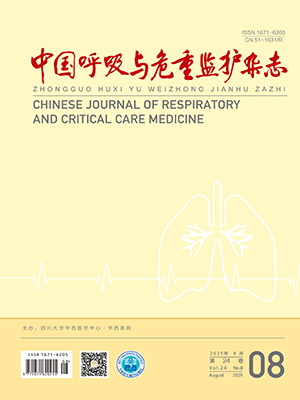| 1. |
陈云, 彭雄, 王彦卿, 等. 肺部手术后支气管胸膜瘘的临床分析. 中南大学学报(医学版), 2017, 42(10): 1163-1168.
|
| 2. |
李亚华, 蒋天, 韩新巍. 支气管胸膜瘘介入治疗及研究进展. 中华介入放射学电子杂志, 2018, 6(1): 81-84.
|
| 3. |
钟志成, 陈兢兢, 高兴林, 等. 房间隔封堵器用于治疗支气管胸膜瘘的进展与争议. 中华结核和呼吸杂志, 2018, 41(6): 490-492.
|
| 4. |
王洪武, 张楠, 李冬妹, 等. 房间隔封堵器治疗支气管残端胸腔瘘二例效果分析. 中华结核和呼吸杂志, 2017, 40(4): 314-315.
|
| 5. |
Kramer MR, Peled N, Shitrit D, et al. Use of Amplatzer device for endobronchial closure of bronchopleural fistulas. Chest, 2008, 133(6): 1481-1484.
|
| 6. |
Spiliopoulos S, Krokidis M, Gkoutzios P, et al. Successful exclusion of a large bronchopleural fistula using an Amplatzer Ⅱ vascular plug and glue embolization. Acta Radiol, 2012, 53(4): 406-409.
|
| 7. |
Papiashvilli M, Bar I, Sasson L, et al. Endobronchial closure of recurrent bronchopleural and tracheopleural fistulae by two amplatzer devices. Heart Lung Circ, 2013, 22(11): 959-961.
|
| 8. |
Ottevaere A, Slabbynck H, Vermeersch P, et al. Use of an amplatzer device for endoscopic closure of a large bronchopleural fistula following lobectomy for a stage Ⅰ squamous cell carcinoma. Case Rep Oncol, 2013, 6(3): 550-554.
|
| 9. |
Fruchter O, El Raouf BA, Abdel-Rahman N, et al. Efficacy of bronchoscopic closure of a bronchopleural fistula with amplatzer devices: long-term follow-up. Respiration, 2014, 87(3): 227-233.
|
| 10. |
Akulian J, Pathak V, Lessne M, et al. A novel approach to endobronchial closure of a bronchial pleural fistula. Ann Thorac Surg, 2014, 98(2): 697-699.
|
| 11. |
Klotz LV, Gesierich W, Schott-Hildebrand S, et al. Endobronchial closure of bronchopleural fistula using Amplatzer device. J Thorac Dis, 2015, 7(8): 1478-1482.
|
| 12. |
Fruchter O, Bruckheimer E, Raviv Y, et al. Endobronchial closure of bronchopleural fistulas with Amplatzer vascular plug. Eur J Cardiothorac Surg, 2012, 41(1): 46-49.
|
| 13. |
Fruchter O, Kramer MR, Dagan T, et al. Endobronchial closure of bronchopleural fistulae using amplatzer devices. Chest, 2011, 139(3): 682-687.
|
| 14. |
Gulkarov I, Paul S, Altorki NK, et al. Use of amplatzer device for endobronchial closure of bronchopleural fistulas. Interact Cardiovasc Thorac Surg, 2008, 133(6): 1481-1484.
|
| 15. |
丁培堃, 杨林. 介入封堵治疗肺切除术后支气管胸膜瘘的研究进展. 中国微创外科杂志, 2017, 17(8): 728-731.
|
| 16. |
张莉, 叶联华, 王高伟, 等. 房间隔封堵器封堵支气管胸膜瘘1例报告. 中国当代医药, 2018, 25(6): 145-147.
|
| 17. |
李强, 姚小鹏, 顾红军, 等. 镍钛合金支气管封堵器在支气管瘘封堵中的应用. 第二军医大学学报, 2004, 25(7): 743-745.
|
| 18. |
李培文, 李宗明, 韩新巍, 等. 覆膜 Y 型单子弹头气道支架治疗左主支气管胸膜瘘 12 例. 介入放射学杂志, 2014, 23(11): 1000-1004.
|
| 19. |
Gómez López A, García Luján R, De Pablo Gafas A, et al. First use of Amplatzer device for bronchopleural fistula after lung transplantation. Thorax, 2017, 72(7): 668-670.
|
| 20. |
Triviño Ramírez AI, Merino Sánchez M, García Polo C. Bronchopleural fistula management with amplatzer insertion. Arch Bronconeumol, 2017, 53(11): 637.
|




